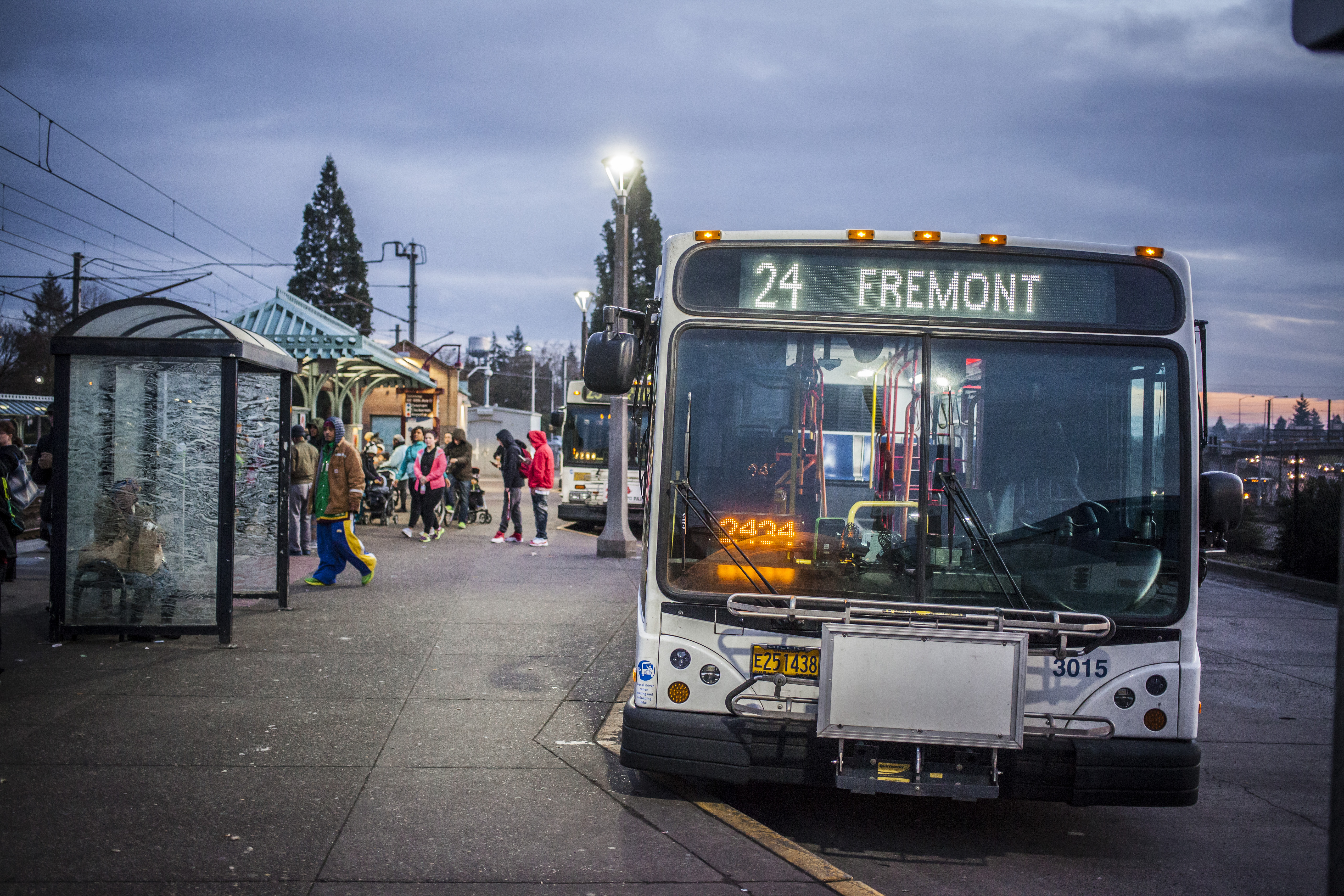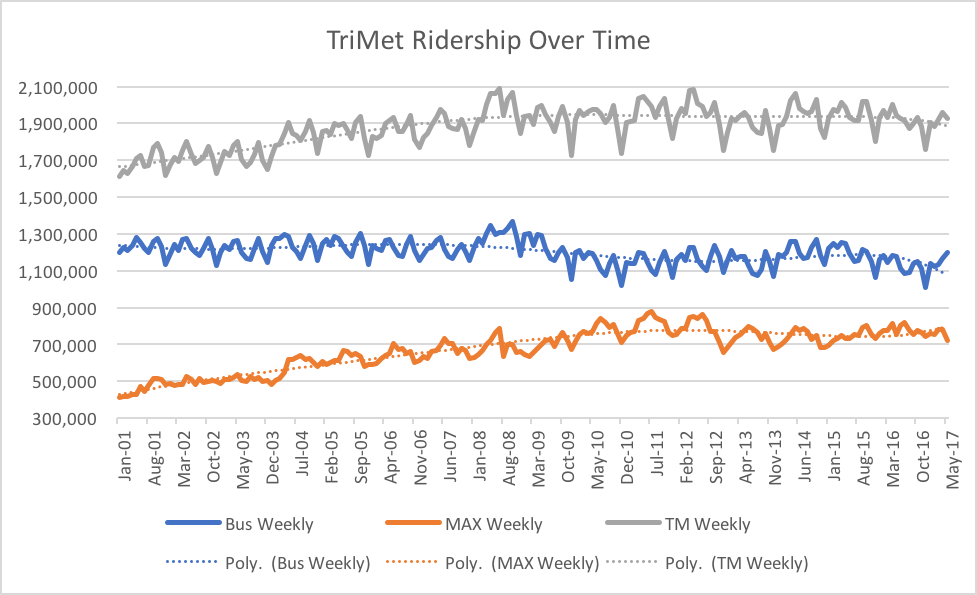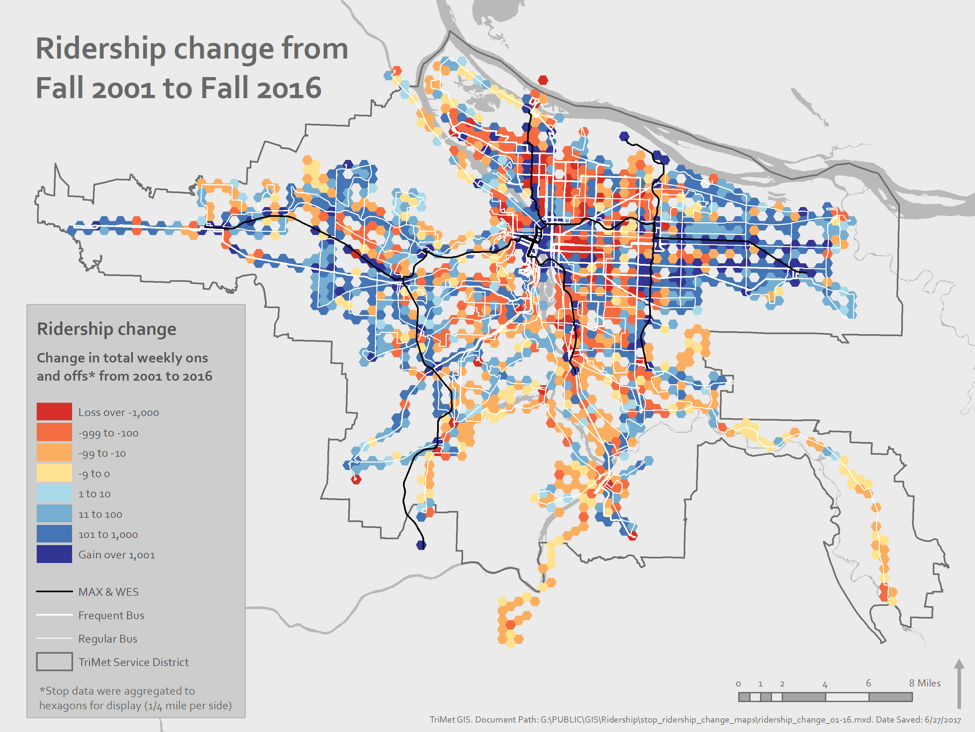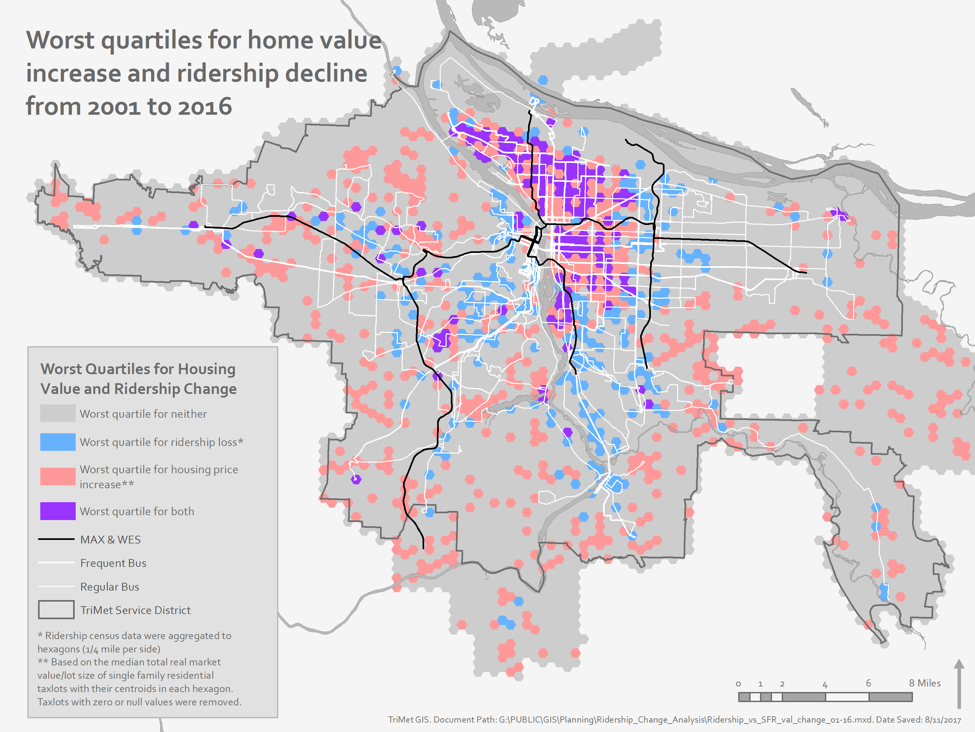
This Ridership Initiative guest post, by TriMet’s Tom Mills & Madeline Steele, is our first from transit agency staff who are working to understand and respond to declining ridership in their system. If your agency would like to share your story or hear from a specific agency or about a particular topic, let us know by emailing [email protected]
Like many transit agencies across the country, TriMet, the transit district serving the Portland, OR, metro region, has seen a recent loss in ridership, principally on its bus system. This ridership loss has been driven by a diverse range of factors including changing employment levels and recession era fare increases and service cuts. TriMet’s analysis surfaced one driver of ridership loss that stood out among the rest: the impact of the economic displacement of low-income earners from inner city neighborhoods to first ring suburbs. These low-income residents used transit for a diverse array of trips before moving to areas with lower quality transit, while the high-income earners taking their place use transit less frequently even though they live in some of the region’s most transit-rich neighborhoods.
TriMet’s total average weekly ridership began to flatten in 2008 and remained flat until a decline between 2015 and 2016. While TriMet’s light rail service, MAX, saw growth in average weekly rides during this time, bus ridership has been in a slow decline since 2001, especially during off-peak travel periods—midday, evenings and weekends.

Recognizing the importance of reversing this decline, we organized an interdepartmental team to identify the causes of TriMet’s eroding bus ridership. The industry’s standard explanations for ridership loss—low fuel prices, more people working 8 a.m. to 5 p.m. shifts (thereby reducing midday ridership), fare increases and service cuts, and system performance—are likely contributing factors in our declining bus ridership, but none showed a strong correlation to ridership loss.

TriMet’s survey data show that since 2003 the share of customers earning a low-income has decreased, while the share of customers earning high incomes has increased substantially. In the same surveys, riders often cited a change in home or work address as the primary reason they rode transit less today than in the past. These findings suggest that one reason TriMet is carrying fewer low-income riders is that their travel patterns are more poorly aligned with high quality transit. So where did these riders go?
Over the last decade, the urban core of Portland has become a high-cost housing market—in fact, the city declared a “housing emergency” in 2015—so we also wanted to explore the possible ridership implications of increased housing costs in Portland.

We used regional tax lot and internal TriMet data to map change in single-family housing values and transit ridership between 2001 and 2016 (full methodology here). Neighborhoods located on the eastside of the Willamette River, just across from Downtown, have seen the most significant displacement in the region due to rising rents, and many of these areas were also traditionally lower- and moderate-income, high ridership neighborhoods.
We found substantial overlap between areas where real market home value increased and transit ridership decreased the most. These areas are concentrated in the same traditionally low-income, inner eastside neighborhoods that have experienced significant economic displacement. Correspondingly, transit ridership grew in areas that saw minimal increases in real market home values. These areas tended to be in the first ring suburbs where many low to moderate-income earners relocated after leaving the inner city.

These economic and demographic dynamics put our most loyal transit riders farther away from our best transit service, and strengthen the market for travel modes that are favored by high-income earning residents who may only use transit to commute. This may result in more walking and biking, but it also likely means more high-income people in and near our congested core are driving or using Uber or Lyft, at least during off-peak hours. At the same time, low-income earners are increasingly concentrated in suburban developments with a dispersed street network, low population densities, single-use land development and a lack of pedestrian infrastructure, all factors that discourage bus ridership.

Having a stronger menu of transportation options is good for TriMet riders and for the region, but we face a challenge as demand for transit shrinks in the most transit-supportive areas with the best transit service levels and demand grows in areas with lower-quality service. We would love to know if this phenomenon is occurring in other metro areas. This remains one of many factors driving transit ridership change, but it is also among the clearest and most challenging to navigate.
After presenting this (and other) analysis to our Board, TriMet intends to address its ridership decline in several ways:
- First, we are expanding service in the suburbs, especially in areas where low-income earning communities reside. While this will likely attract fewer rides per hour than inner city service, we believe it is important to provide access to quality transit in these areas in order to win back customers.
- In addition, TriMet is in discussions with cities in the region to make roadway and signal improvements that help buses move through traffic congestion, including bus lanes, queue jumps, business access transit lanes and pro-time parking. We have also been encouraging and partnering with cities, counties, and the Oregon DOT over the last five years to improve sidewalks and crossings to make access to transit safer and easier.
- Lastly, we are developing a low-income fare program to make it easier for customers living in poverty to ride transit. Although the primary intent of this program is to help reduce the cost of riding transit for those who can least afford it, we hope this will also help win back and attract new customers, including those living in the suburbs.
These combined efforts are meant to improve the reach and quality of our system, making transit more appealing to all communities in the Portland region. This will help support our efforts to improve the lives of residents and employees in our District, supporting our vision to “do our part in making our community the best place to live in the country.”
Tom Mills is a Senior Planner at TriMet
Madeline Steele is a GIS Data Analyst at TriMet
 On the Brink: Will WMATA’s Progress Be Erased by 2024?
On the Brink: Will WMATA’s Progress Be Erased by 2024?
The experience of being a WMATA rider has substantially improved over the last 18 months, thanks to changes the agency has made like adding off-peak service and simplifying fares. Things are about to get even better with the launch of all-door boarding later this fall, overnight bus service on some lines starting in December, and an ambitious plan to redesign the Metrobus network. But all of this could go away by July 1, 2024.
Read More Built to Win: Riders Alliance Campaign Secures Funding for More Frequent Subway Service
Built to Win: Riders Alliance Campaign Secures Funding for More Frequent Subway Service
Thanks to Riders' Alliance successful #6MinuteService campaign, New York City subway riders will enjoy more frequent service on nights and weekends, starting this summer. In this post, we chronicle the group's winning strategies and tactics.
Read More